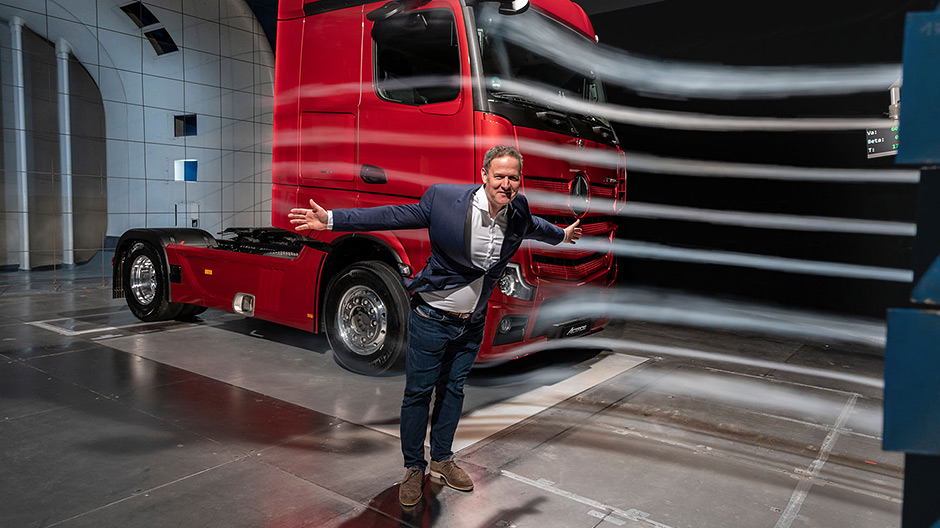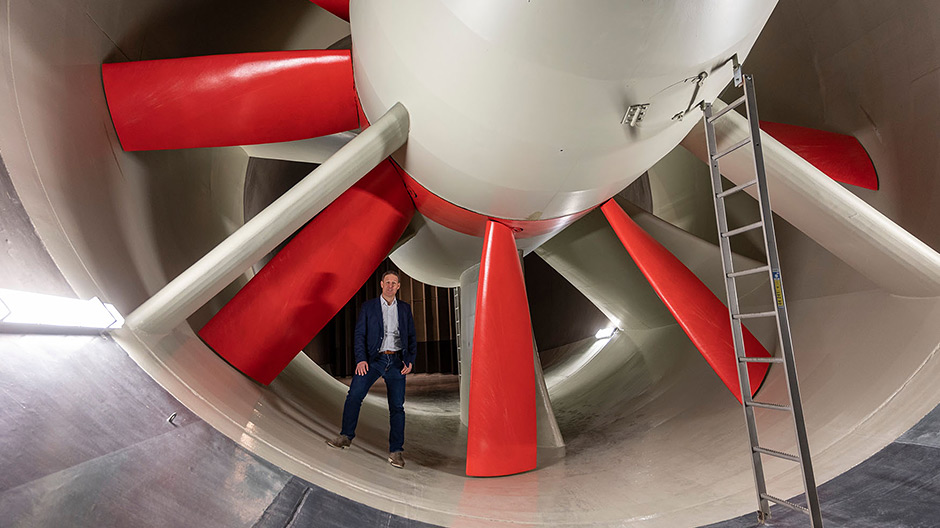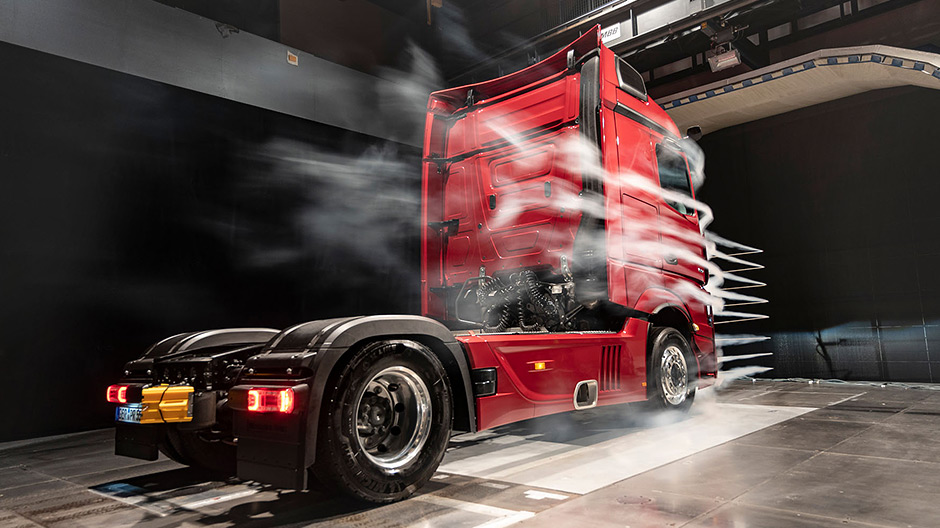
Aerodynamics are measurable: the art of the Mercedes-Benz developers is revealed in the wind tunnel
Vehicle & Technology
The new Actros consumes up to five percent less fuel than its predecessor. This is due in part to its improved aerodynamics. This improvement has been achieved with the help of tests on the computer, on the road – and in the wind tunnel.

Michael Hilgers, Head of CAE Vehicle Functions in Commercial Vehicle Development at Mercedes‑Benz, presents the power of the fan in the wind tunnel at Untertürkheim.
You could put the giant fan to excellent use as the backdrop for the latest Hollywood production – and pretend that it is the engine of a gigantic spaceship. The diameter of the axial fan is 8.5 metres and each of the nine red-painted blades are two and a half metres long. Today pictures are being taken at the facility. Not moving pictures, but portrait photos of Michael Hilgers, Head of CAE Vehicle Functions in the Commercial Vehicle Development Division of Mercedes‑Benz.
Here in the wind tunnel at Daimler AG in Stuttgart-Untertürkheim, Hilgers and his colleagues have made a significant contribution towards making the new Actros more aerodynamic and in turn more fuel-efficient than every other preceding model.

Just how important aerodynamics are, is shown by the following statistic: in a modern truck in European long-distance operations, around one third of the available mechanical energy is needed to overcome the air resistance. The smaller this resistance, i.e. the more aerodynamic the truck, the lower its consumption is. The new Actros can save up to five percent fuel compared with its predecessor. Up to 1.5 percent is due alone to the aerodynamically optimised MirrorCam which replaces the classic outside mirrors.
How did Untertürkheim contribute to the aerodynamics of the new Actros? If required the wind tunnel fan can simulate storm winds with speeds of up to 250 kilometres an hour. During the development phase the aerodynamics specialists subjected the vehicle to winds in the tunnel several times in order to simulate air flow conditions. To do this the truck was positioned on a turntable platform with an integrated weighbridge.
Optimising the Cd value with simulations.
The goal of simulations like these is to optimise the Cd value or “wind slip” of a truck. “We carry out random spot checks to confirm the improvement to the aerodynamics of concept components,” Michael Hilgers explains the basic approach. “Computer-based flow calculations are always carried out in parallel: digital simulation using so-called computational fluid dynamics, CFD for short.” Also the aerodynamic measures are validated in road operations.
With regard to the new Actros, the work in the wind tunnel provided
valuable information on the design of the MirrorCam as well as about
the position of its camera arms on the right and left-hand side of the
cab. “The upper and the lower area of the A-pillar as well as the
upper area of the B-pillar were up for debate,” Michael Hilgers
explains.
For these trials, a real Actros was used, on which the
outside mirrors were replaced by prototypes of the camera arms –
mounted one after the other at the three test positions. The truck was
placed on the weighbridge in the wind tunnel and the fan was started.
The truck weighbridge allowed the engineers to measure the air force
acting on the vehicle as the air flowed around it. Result: the best
position for the camera arm is on the A-pillar close to the roof edge.
A solution was also sought that would prevent stray light from above reducing the performance of the cameras. In these tests, the small hood with which the MirrorCam arms are now equipped prevailed. And the engineers were also intensely involved in the development of the new, concave cab side deflectors. The optimised cab side deflectors also contribute to the new Actros consuming less fuel than any of its predecessors.
Focus also on preventing dirt.
In addition to reducing fuel consumption, the engineers also focused on keeping dirt away from the vehicle during their wind tunnel tests and CFD analyses. “The safety-relevant areas such as the windscreen and side windows, not to mention the lenses of the camera arms are of particular concern,” Hilgers explains. The aerodynamics influence how much dirt kicked up by your own vehicle and vehicles in front actually remains stuck to the vehicle.
Not only is the aerodynamics specialists’ own work essential, but also the co-operation with colleagues from other core disciplines – with the designers and design engineers in particular. Because not everything that serves to improve aerodynamics is desirable from a designer's point of view or can be realised by design engineers.
And the aerodynamics specialists have to veto some of their colleagues’ ideas too. “However at the end of the day all of those involved are aware of one particular thing,” Michael Hilgers emphasises: “It is always about developing the best solution as a team.”

Facing the flow: the developers’ work in the wind tunnel focused on the camera arms of the MirrorCam and the side deflectors of the cab.
Photos: Daimler, Lars Kruse




Comment
Please log in to post a comment.
8 comments
wir danken für dein Feedback und geben den Hinweis gern weiter. Solche Ideen sind wichtig für die Entwicklung unserer Trucks.
Da die Wirksamkeit der wasserabweisenden Beschichtung auf der MirrorCam-Linse im Laufe der Zeit und unter bestimmten Bedingungen (z. B. Art und Häufigkeit der Reinigung) abnehmen kann, würden wir dir empfehlen, die Linse mit einem Scheibenversiegelungsmittel (z. B. Brestol oder Rain-X) zu behandeln.
wir danken für dein Feedback und geben den Hinweis gern weiter. Solche Ideen sind wichtig für die Entwicklung unserer Trucks.
Da die Wirksamkeit der wasserabweisenden Beschichtung auf der MirrorCam-Linse im Laufe der Zeit und unter bestimmten Bedingungen (z. B. Art und Häufigkeit der Reinigung) abnehmen kann, würden wir dir empfehlen, die Linse mit einem Scheibenversiegelungsmittel (z. B. Brestol oder Rain-X) zu behandeln.
Wäre da nicht eine Messung als Komplettzug realistischer?
Wäre da nicht eine Messung als Komplettzug realistischer?
stimmt! Auch für den Gliederzug errechnen die Ingenieure die Aerodynamik, indem sie den gesamten Lastzug berücksichtigen.
stimmt! Auch für den Gliederzug errechnen die Ingenieure die Aerodynamik, indem sie den gesamten Lastzug berücksichtigen.
wir haben nochmal unsere Aerodynamiker befragt: Die Aerodynamik wird mit dem gesamten Sattelzug ideal bewertet. Verbrauchsfahrten und Simulationsrechnungen werden deshalb immer mit Trailer durchgeführt. Im Windkanal in Untertürkheim wird der Effekt des Trailers normalerweise mit einem Aufbau hinter dem Fahrerhaus imitiert (sieht man auf den Fotos hier nicht).
wir haben nochmal unsere Aerodynamiker befragt: Die Aerodynamik wird mit dem gesamten Sattelzug ideal bewertet. Verbrauchsfahrten und Simulationsrechnungen werden deshalb immer mit Trailer durchgeführt. Im Windkanal in Untertürkheim wird der Effekt des Trailers normalerweise mit einem Aufbau hinter dem Fahrerhaus imitiert (sieht man auf den Fotos hier nicht).